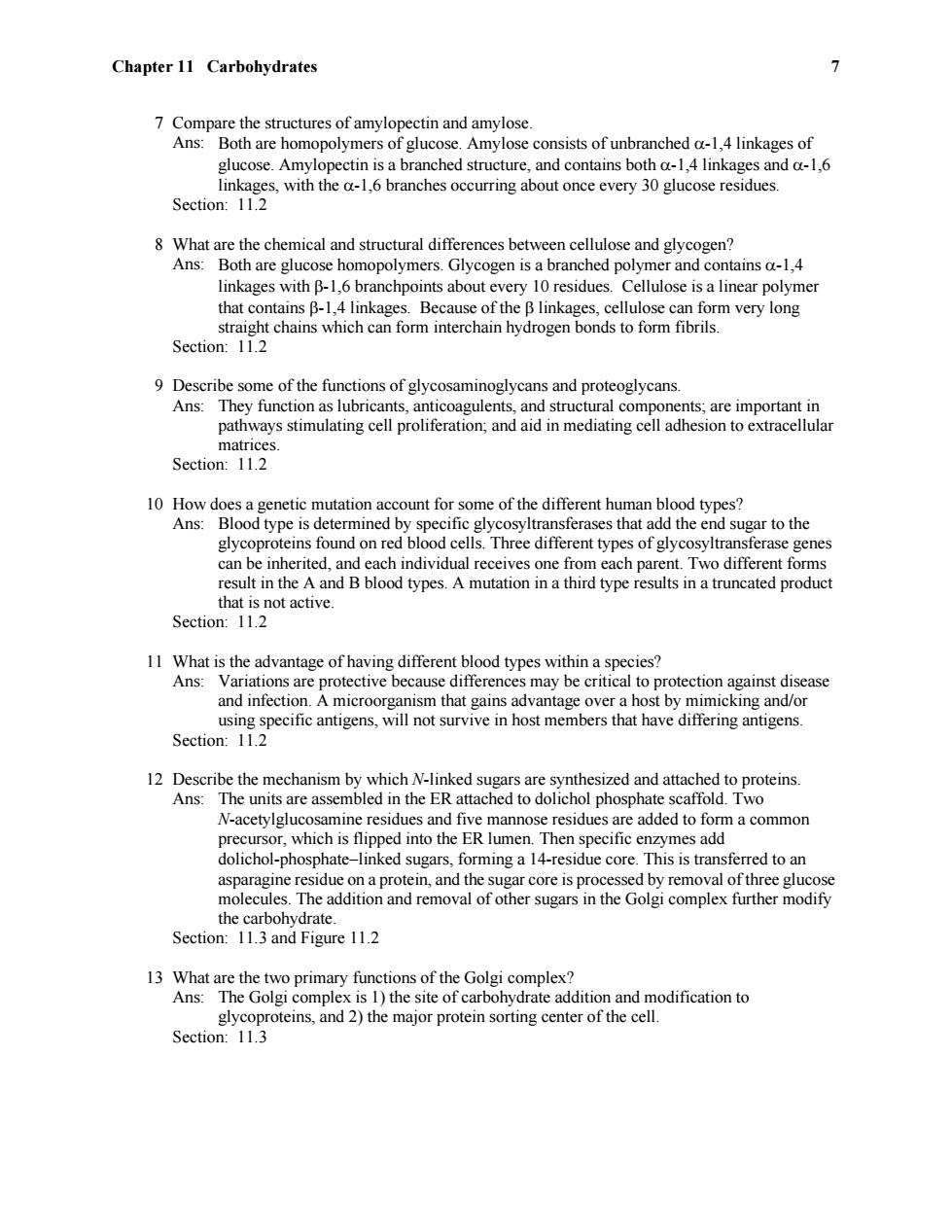正在加载图片...

Chapter 11 Carbohydrates 7 7 Compare the structures of amylopectin and amylose. Ans:Both are homopolymers of glucose.Amylose consists of unbranched a-1,4 linkages of glucose.Amylopectin is a branched structure,and contains both a-1,4 linkages and a-1,6 linkages,with the a-1,6 branches occurring about once every 30 glucose residues. Section:11.2 8 What are the chemical and structural differences between cellulose and glycogen? Ans:Both are glucose homopolymers.Glycogen is a branched polymer and contains a-1,4 linkages with B-1,6 branchpoints about every 10 residues.Cellulose is a linear polymer that contains B-1,4 linkages.Because of the B linkages,cellulose can form very long straight chains which can form interchain hydrogen bonds to form fibrils. Section:11.2 9 Describe some of the functions of glycosaminoglycans and proteoglycans. Ans: They function as lubricants,anticoagulents,and structural components;are important in pathways stimulating cell proliferation;and aid in mediating cell adhesion to extracellular matrices. Section:11.2 10 How does a genetic mutation account for some of the different human blood types? Ans:Blood type is determined by specific glycosyltransferases that add the end sugar to the glycoproteins found on red blood cells.Three different types of glycosyltransferase genes can be inherited,and each individual receives one from each parent.Two different forms result in the A and B blood types.A mutation in a third type results in a truncated product that is not active. Section:11.2 11 What is the advantage of having different blood types within a species? Ans:Variations are protective because differences may be critical to protection against disease and infection.A microorganism that gains advantage over a host by mimicking and/or using specific antigens,will not survive in host members that have differing antigens. Section:11.2 12 Describe the mechanism by which N-linked sugars are synthesized and attached to proteins. Ans:The units are assembled in the ER attached to dolichol phosphate scaffold.Two N-acetylglucosamine residues and five mannose residues are added to form a common precursor,which is flipped into the ER lumen.Then specific enzymes add dolichol-phosphate-linked sugars,forming a 14-residue core.This is transferred to an asparagine residue on a protein,and the sugar core is processed by removal of three glucose molecules.The addition and removal of other sugars in the Golgi complex further modify the carbohydrate. Section:11.3 and Figure 11.2 13 What are the two primary functions of the Golgi complex? Ans:The Golgi complex is 1)the site of carbohydrate addition and modification to glycoproteins,and 2)the major protein sorting center of the cell. Section:11.3Chapter 11 Carbohydrates 7 7 Compare the structures of amylopectin and amylose. Ans: Both are homopolymers of glucose. Amylose consists of unbranched -1,4 linkages of glucose. Amylopectin is a branched structure, and contains both -1,4 linkages and -1,6 linkages, with the -1,6 branches occurring about once every 30 glucose residues. Section: 11.2 8 What are the chemical and structural differences between cellulose and glycogen? Ans: Both are glucose homopolymers. Glycogen is a branched polymer and contains -1,4 linkages with -1,6 branchpoints about every 10 residues. Cellulose is a linear polymer that contains -1,4 linkages. Because of the linkages, cellulose can form very long straight chains which can form interchain hydrogen bonds to form fibrils. Section: 11.2 9 Describe some of the functions of glycosaminoglycans and proteoglycans. Ans: They function as lubricants, anticoagulents, and structural components; are important in pathways stimulating cell proliferation; and aid in mediating cell adhesion to extracellular matrices. Section: 11.2 10 How does a genetic mutation account for some of the different human blood types? Ans: Blood type is determined by specific glycosyltransferases that add the end sugar to the glycoproteins found on red blood cells. Three different types of glycosyltransferase genes can be inherited, and each individual receives one from each parent. Two different forms result in the A and B blood types. A mutation in a third type results in a truncated product that is not active. Section: 11.2 11 What is the advantage of having different blood types within a species? Ans: Variations are protective because differences may be critical to protection against disease and infection. A microorganism that gains advantage over a host by mimicking and/or using specific antigens, will not survive in host members that have differing antigens. Section: 11.2 12 Describe the mechanism by which N-linked sugars are synthesized and attached to proteins. Ans: The units are assembled in the ER attached to dolichol phosphate scaffold. Two N-acetylglucosamine residues and five mannose residues are added to form a common precursor, which is flipped into the ER lumen. Then specific enzymes add dolichol-phosphatelinked sugars, forming a 14-residue core. This is transferred to an asparagine residue on a protein, and the sugar core is processed by removal of three glucose molecules. The addition and removal of other sugars in the Golgi complex further modify the carbohydrate. Section: 11.3 and Figure 11.2 13 What are the two primary functions of the Golgi complex? Ans: The Golgi complex is 1) the site of carbohydrate addition and modification to glycoproteins, and 2) the major protein sorting center of the cell. Section: 11.3